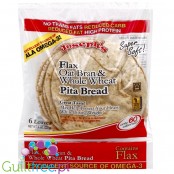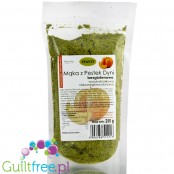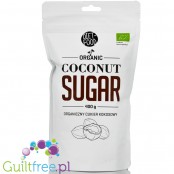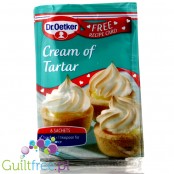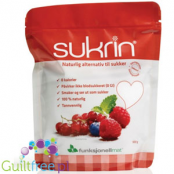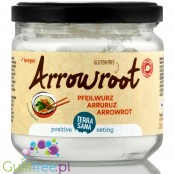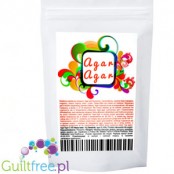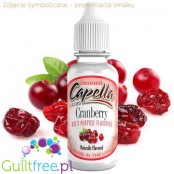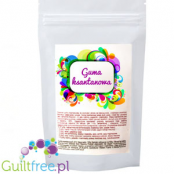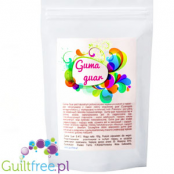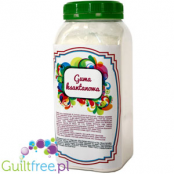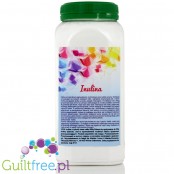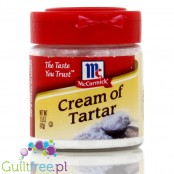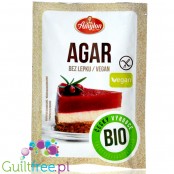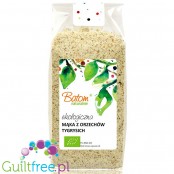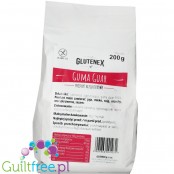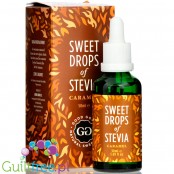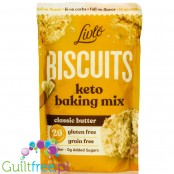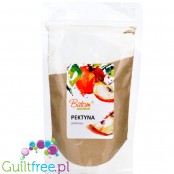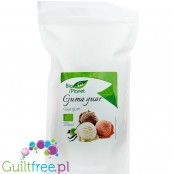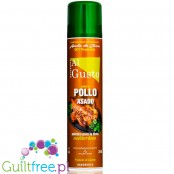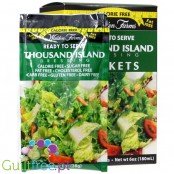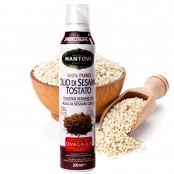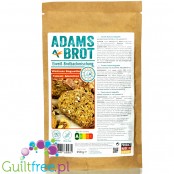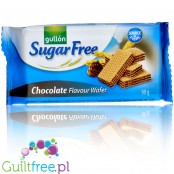Hotline: 885 925 336
E-mail: sklep@guiltfree.pl
Fast shipping up to 48 hours
As many as 12 949 light products
Natural xanthan gum. E-415 100g
Xanthan gum (a.k.a. dextran or gellan gum) is a natural plant gum from the polysaccharide group (multi-molecular polysaccharides), rich in fiber and almost fat-free.
Xanthan gum is water-soluble and has excellent thickening properties.
Adding xanthan gum to food reduces its caloric content per unit volume, increases its fiber content and satiating properties (feeling of fullness after a meal). Xanthan gum binds a great deal of water and can also be used as a fat substitute - i.e. as a vegetable thickener and stabilizer.
Xanthan flour is soluble in cold and warm water, milk, sweet and salty liquids, and <20% alcohol.
Xanthan-thickened food products have a stable consistency resistant to acid/alkaline reaction (within pH 1-13), temperature and mixing.
Products thickened with xanthan gum can be both heated and frozen.
Application and dosage of xanthan gum
Depending on the chemical properties of the substance to be thickened and the density you want in the finished meal:
- Below 0.25 g/kg: fermented dairy drinks (buttermilk, kefir, curdled milk)
- Less than 2 g/kg: non-fermented dairy drinks (shake, yogurt, milkshake)
- Less than 3 g/kg: dessert, jelly, kisel
- Less than 5 g/kg: tomato sauce, cottage cheese desserts, cheese, cheesecake, yogurt and mayonnaise sauces
- Less than 6 g/kg: fruit and vegetable sauces and creams, canned vegetables in marinade, dairy desserts
- Less than 10 g/kg: jams, jellies and marmalades, fruit toppings, ice cream, low-fat processed cheeses
- Less than 10 g/kg: mixtures of butter and vegetable fats
- Less than 12.5 g/kg: low-fat homogenized type cheeses
- Less than 20 g/kg: vegetable pastes
- Less than 35 g/kg: salad dressings, low-fat mayonnaise
- As needed: baked goods, pastries, side dishes, desserts, cakes and icing, soft drinks and fruit drinks with fruit particles.
What are the reasons for the differences in the declared caloric content of xanthan gum from different manufacturers?
Differences in the claimed caloric content of xanthan gum from different manufacturers are mainly due to the question of the contentious caloric content of the fiber. Xanthan gum is a thickening substance that is largely composed of fiber. The energy value of fiber is not clearly defined, as its caloric content depends on how it is metabolized in the body.
Key Factors Affecting Declared Caloricity:
-
Type of Fiber:
- Fiber can be soluble or insoluble. Soluble fiber, such as xanthan gum, can be partially fermented by intestinal bacteria, which can produce a certain amount of calories.
-
Degree of Fermentation:
- Some types of fiber ferment in the gut, producing short-chain fatty acids (SCFAs) that can be absorbed by the body and provide energy. The degree of this fermentation varies depending on the type of fiber and individual gut microflora.
-
National and Regional Standards:
- Different countries and regions may have different standards for how the caloric content of fiber should be calculated and declared. For example, in some countries fiber is largely considered non-caloric, while in others its caloric content is included in the declaration.
-
Methods of Analysis:
- Laboratory methods used to analyze the caloric content of fiber can vary, leading to different results. Some methods may consider full fermentation of the fiber, while others may consider only partial fermentation or no fermentation.
-
Manufacturer Declarations:
- A manufacturer may choose how to represent calories based on available research, accepted standards or its own analysis. This can lead to different calorie declarations even for similar products.
Examples of Calorie Fiber:
- 130 kcal/100g: This value may suggest that the manufacturer takes into account minimal fermentation of the fiber or recognizes that most of the fiber is not metabolized.
- 170 kcal/100g: This is a more moderate value that may suggest partial fermentation of the fiber and the production of some energy.
- 350 kcal/100g: This high value suggests full fermentation of fiber and maximum energy production, which may be a more theoretical approach.
Benefits of Fiber in Xanthan Gum:
- High Fiber Content: Helps regulate digestion and supports gut health.
- Low Calorie: Despite differences in claims, xanthan gum remains a low-calorie product, which is beneficial in reduction diets.
- Culinary versatility: It can be used to thicken soups, sauces, desserts, and in gluten-free baking.
Summary:
Differences in the claimed caloric content of xanthan gum are mainly due to differences in approaches to the caloric content of the fiber, the degree of fermentation, and the standards and methods of analysis used by manufacturers. Despite these differences, xanthan gum remains a valuable dietary ingredient that supports gut health and offers versatile culinary applications.
Nutrition Facts
Your review appreciation cannot be sent
Report comment
Report sent
Your report cannot be sent
Write your review
Review sent
Your review cannot be sent
Xanthan gum E-415
Ingredients: xanthan gum E-41
Net weight: 100g
Country of origin: China.
Allergens: Possible presence of gluten, mustard, nuts, celery, sesame and soy.
Packaged in Poland for: Walden Farms K.Warda-Poniecka, Wola Golkowska www.Guiltfree.pl
Product suitable for vegans.
Store in a dry place, in a tightly closed container.
Featured Products
Joseph's Flax Oat Bran & Whole Weat Pita Bread Pita bread
Efavit partially defatted pumpkin seed flour 18g protein
Diet Food organic coconut sugar
Dr. Oetker Cream of Tartar 6 x 5g tartaric potassium tartrate E336i
Syrop słodzący 0 kalorii Splenda /sukraloza/
Sukrin is a natural sweetener with erythritol
E-412 guar gum
Carrageenan Kappa E407, 100g
Terra Sana arrow root
Agar E406 100g vegan thickener
Capella Cranberry concentrated flavor
Franky's Bakery Candy Flavor Powdered Food Flavoring, Cheesecake
Pure, gluten free organic cream of tartare E336, 150g
Xanthan gum E-415
Guar Gum E-412
Xanthan gum E-415
Chia Sage Spanish
Fiber cleansing vital
Livity, Agar Agar, vegetable gelling agent from seaweed
Inulin with chicory root
TerraSana gray kuzu - gluten-free rooted kuzu starch from certified organic crops
McCormick's cream of tartar sour potassium tartar E336i
Amylon Agar-Agar, gluten free certified
Efavit defatted Evening Primrose Seed Meal
Good Good Sweet Drops of Stevia, Coconut flavor
Good good sweet drops of stevia, vanilla flavor
Good Good Sweet Drops of Stevia, Chocolate flavor
Batom tiger nuts flour
Helocm gluten free defatted pumpkin seed flour 48g protein
Batom Apple & Citrus Pectine 30g, natural, vegan single-ingredient thickener for fruit jams, spreads and sauces
Glutenex gluten free guar gum
Meridian Superfoods Tiger Nut & Peanut Butter
Keto Bakes Frosted Fudgy Brownies Mix 11.9 oz
Good Good Sweet Drops of Stevia Raspberry, liquid food flavoring with stevia
Good Good Sweet Drops of Stevia Strawberry, liquid food flavoring with stevia
Good Good Sweet Drops of Stevia Caramel, liqud caramel flavoring with stevia
Keto Bakes Pumpkin Cream Cheese Muffins Mix 12.9 oz
Livlo Keto Biscuits Baking Mix, Classic Butter 9.4 oz
Livlo Keto Brownies Baking Mix 9 oz
Miss Jones Keto Paleo Fudgy Brownie Mix
Batom Apple Pectine 150g, natural, vegan single-ingredient thickener for fruit jams, spreads and sauces
Guar Gum E-412
Konjac Shop Glucomanano de Konjac 250g - based food supplement
Locco 0kcal Stevia Drops, Caramel
Funky Flavors Sweet Coconut Waffelight - flavoring drops without sugar
Batom, Organic Blue Spirulina 15g
Sukrin Finesse Baking Sweetener is a natural sweetener with isomalt, erythritol, sucralose
Other customers also chose
Aerosoles Al Gusto Grilled Chicken - smakowa oliwa extra virgin w spray'u, smak Grillowany Kurczak
PAM® Baking with real flour
GymQueen Fluffy Vegan Protein Bar, Vanilla Cashew
Sante Go On! Almond butter 180g
Walden Farms 1000 Islands Dressing
FIZI Special Brownie Babe - vegan chocolate bar
Mantova Roasted Sesame Spray, no propellants
Adam's Walnut Baguette - low-carbohydrate baguette with walnuts, baking mix
Funky Flavors Highly concentrated Milk Chocolate flavor for shakes, desserts, yogurt, ice cream & pancakes
Boostball Burners Keto Mint Choc Chip
Gullón Wafer Diet Nature Vanilla - sugar fre waffers with cocoa cream
Funky Flavors Rum calorie free, fat free liquid food flavoring
Santini Christmas Tree sugar free lollipop with xylitol
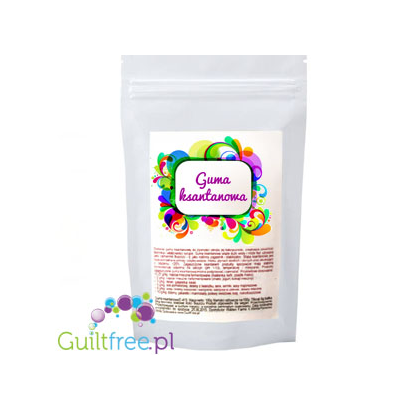
A natural fiber-rich substance used to thicken food products and reduce their caloric content




